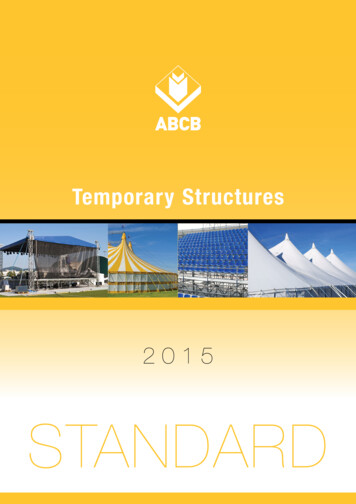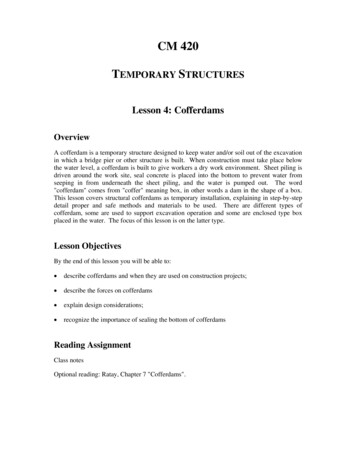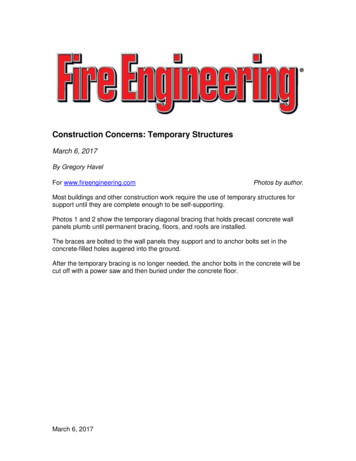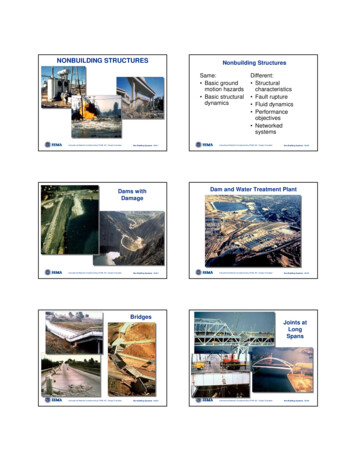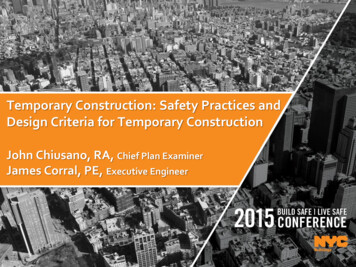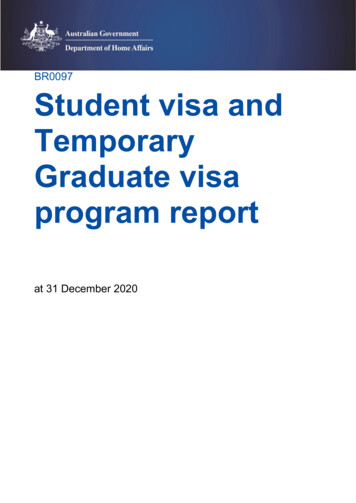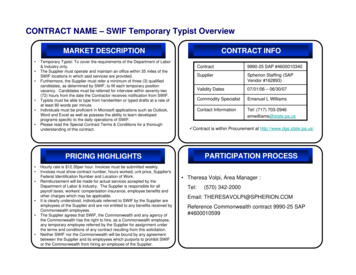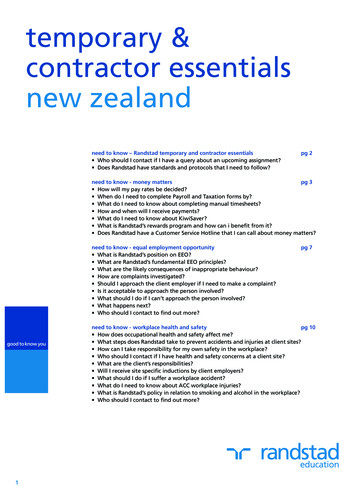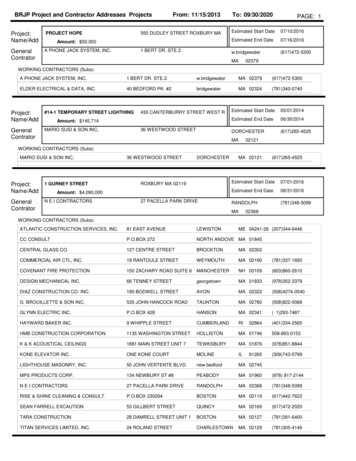
Transcription
ATCE--IIIIATCEATCE-IIAdvanced Topics in Civil EngineeringFormwork for ed Topics in Civil EngineeringATCE-II : Temporary StructuresAdvanced Topics in Civil Engineering The first part of ATCE-II will deal with the materials,methods and techniques associated with temporarystructures utilized in various construction operations,such as: concrete formwork construction scaffolding falsework/shoring cofferdams underpinning diaphram/slurry walls earth-retaining structures construction dewatering. A major emphasis will be placed on concrete formworkconstruction covering detailed design analysis of bothvertical and horizontal timber formwork systems.TemporaryStructuresFormwork ForConcrete2ATCE-IIATCEATCE-IIAdvanced Topics in Civil EngineeringATCE-II - Temporary Structures There will be four quizzes and a final exam. Hurd, M. K., Formwork forConcrete. 6th edition, AmericanConcrete Institute, Detroit, Michigan,1995. Ratay, Robert T., Handbook ofTemporary Structures inConstruction. 2nd edition, McGrawHill, New York, 1996.The course final grade will be calculatedbased on the following weights: 20% 25% 10% 45% forforforforAdvanced Topics in Civil EngineeringRecommended Textbooks:Quizzed will be given throughout the semester,sometimes unannounced.Final exam will be given on Tuesday February 7th. Grading System: ATCE-IIATCEATCE-IIATCE-II - Temporary Structureshomework assignmentsthree quizzesattendance and participationthe final exam.All exams will be closed book.3ATCE-IIATCEATCE-IIAdvanced Topics in Civil Engineering4ATCE-IIATCEATCE-IIAdvanced Topics in Civil EngineeringFormwork for ConcreteFormwork for Concrete Formwork development has paralleled thegrowth of concrete constructionthroughout the 20th century. The increasing acceptance of concrete asa major construction material presentsthe form builder a new range of problemsin the development of appropriatesheathing materials and maintenance ofrigid tolerances. Formwork is a classic temporarystructure in the sense that: it is erected quickly highly loaded for a few hoursduring the concrete placement and within a few daysdisassembled for future use. Also classic in their temporarynature are the connections, braces,tie anchorages, and adjustmentdevices which forms need.5Professor Kamran M. NematiSecond Semester 200561
ATCE--IIIIATCEATCE-IIAdvanced Topics in Civil EngineeringFormwork for ConcreteATCE-IIATCEATCE-IIAdvanced Topics in Civil EngineeringATCE-IIATCEATCE-IIAdvanced Topics in Civil EngineeringFormwork for ConcreteFormwork for Concrete The term "Temporary Structures" may not fullyimply the temporary, since some forms, tiehardware, and accessories are used hundredsof times, which necessitates high durability andmaintainability characteristics and design thatmaximizes productivity. Unlike conventional structures, the formworkdisassembly characteristics are severelyrestricted by concrete bond, rigidity, andshrinkage, which not only restricts access to theformwork structure but causes residual loadsthat have to be released to allow stripping fromthe concrete which initiates disassembly. Lumber was once the predominant formmaterial, but developments in the use ofplywood, metal, plastics, and other materials,together with the increasing use of specializedaccessories have changed the picture. Formwork was formerly built in place, usedonce, and wrecked. Because of high labor costs in the U.S., thetrend today is toward increasing prefabrication,assembly in large units, erection by mechanicalmeans such as “flying” forms into place bycrane, and continuing reuse of the forms.7ATCE-IIATCEATCE-IIAdvanced Topics in Civil EngineeringFormwork for Concrete8ATCE-IIATCEATCE-IIAdvanced Topics in Civil EngineeringFormwork for Concrete In 1908 the use of wood versus steel formwork wasdebated at the ACI convention. Also, the advantagesof modular panel forming with its own connectinghardware, and good for extensive reuse were realized. By 1910 steel forms for paving were being producedcommercially and used in the field. Today modular panel forming is the norm.A 1909 constructionscene shows thefirst application ofsteel forms forstreet paving.9ATCE-IIATCEATCE-IIAdvanced Topics in Civil Engineering10ATCE-IIATCEATCE-IIAdvanced Topics in Civil EngineeringObjectives of Form BuildingObjectives of Form Building Forms mold the concrete to desired sizeand shape and control its position andalignment. But formwork is more than a mold; it is atemporary structure that supports: Basic objectives in form building are threefold: its own weight the freshly placed concrete construction live loads (including materials,equipment, and personnel). Cooperation and coordination betweenengineer / architect and the contractor arenecessary to achieve these goals.11Professor Kamran M. NematiSecond Semester 2005Quality - In terms of strength, rigidity,position, and dimensions of the formsSafety - for both the workers and theconcrete structureEconomy - the least cost consistent withquality and safety requirements122
ATCE--IIIIATCEATCE-IIAdvanced Topics in Civil EngineeringFormwork for ConcreteATCE-IIATCEATCE-IIAdvanced Topics in Civil EngineeringATCE-IIATCEATCE-IIAdvanced Topics in Civil EngineeringObjectives of Form BuildingHow Formwork Affects Concrete Quality Economy is a major concern since formworkcosts constitutes up to 60 percent of the totalcost of concrete work in a project. Size, shape, and alignment of slabs, beams,and other concrete structural elements dependon accurate construction of the forms. The forms must be:Form w orkLaborCostFormw orkm aterialcost Concrete,rebar,footings,placem ent In designing and building formwork, thecontractor should aim for maximum economywithout sacrificing quality or safety.ATCE-IIATCEATCE-IISufficiently rigid under the construction loads tomaintain the designed shape of the concrete,Stable and strong enough to maintain largemembers in alignment, andSubstantially constructed to withstand handling andreuse without losing their dimensional integrity. The formwork must remain in place until theconcrete is strong enough to carry its ownweight, or the finished structure may bedamaged.13Advanced Topics in Civil EngineeringCauses of Formwork Failure14ATCE-IIATCEATCE-IIAdvanced Topics in Civil EngineeringCauses of Formwork Failure Formwork failures are the cause of many accidents andfailures that occur during concrete construction whichusually happen when fresh concrete is being placed. Generally some unexpected event causes one memberto fail, then others become overloaded or misalignedand the entire formwork structure collapses.Formwork collapsecauses injuries, lossof life, propertydamage, andconstruction delays The main causes of formwork failure are:1 - Improper stripping and shore removal2 - Inadequate bracing3 - Vibration4 - Unstable soil under mudsills*, shoringnot plumb5 - Inadequate control of concreteplacement6 - Lack of attention to formwork details.*Mudsill: A plank, frame, or small footing on the ground used as a base for ashore or post in formwork.15ATCE-IIATCEATCE-IICauses of FailureAdvanced Topics in Civil Engineering16ATCE-IIATCEATCE-IIAdvanced Topics in Civil EngineeringCauses of FailureImproper Stripping and Shore RemovalInadequate Bracing Premature stripping of forms, premature removal ofshores, and careless practices in re-shoring canproduce catastrophic results. The more frequent causes of formwork failure,however, are other effects that induce lateralforce components or induce displacement ofsupporting members. Inadequate cross bracing and horizontalbracing of shores is one of the factors mostfrequently involved in formwork accidents. Investigations prove that many accidentscausing thousands of dollars of damage couldhave been prevented only if a few hundreddollars had been spent on diagonal bracing forthe formwork support.Case study:Too early shore removal at Bailey'sCrossroads in Virginia (1972):26-stories apartment buildingForms were supported by floors 7-daysold or olderFailure occurred on the 24th floor, whereit was shored to the 5-day-old 23rd floor.The overloaded 23rd floor failed in sheararound one or more columns,triggering a collapse that carried throughthe entire height of the building.17Professor Kamran M. NematiSecond Semester 2005183
ATCE--IIIIATCEATCE-IIAdvanced Topics in Civil EngineeringFormwork for ConcreteATCE-IIATCEATCE-IIAdvanced Topics in Civil EngineeringCauses of FailureInadequate Bracing Use of Diagonal Bracing High shoring with heavy load at the top isvulnerable to eccentric or lateral loading.ATCE-IIATCEATCE-IICase study:New York ColiseumFormwork collapse,where rapiddelivery ofconcreteintroduced lateralforces at the top ofhigh shoring. Diagonal bracing improves the stability of sucha structure, as do guys or struts to solid groundor competed structures.19ATCE-IIATCEATCE-IIAdvanced Topics in Civil EngineeringCauses of FailureInadequate Bracing Use of Diagonal BracingCase study: New York Coliseum Increased diagonal bracing was added to allremaining shoring, following partial collapse offormwork.21ATCE-IIATCEATCE-IIAdvanced Topics in Civil EngineeringAdvanced Topics in Civil EngineeringCauses of FailureInadequate Bracing The main exhibition floor of the New York Coliseumcollapsed when concrete was being placed. Forms for the floor slab were supported on twotiers of shores.20ATCE-IIATCEATCE-IIAdvanced Topics in Civil EngineeringCauses of FailureInadequate Bracing Use of Diagonal Bracing When a failure occurs at one part, inadequatebracing may permit the collapse to extend to alarge portion of the structure and multiply thedamage. Suppose a worker accidentally rams orwheelbarrow into some vertical shores anddislodges a couple of them. This may set up achain of reaction that brings down the entirefloor. One major objective of bracing is to prevent sucha minor accident or failure from becoming adisaster.22ATCE-IIATCEATCE-IIAdvanced Topics in Civil EngineeringCauses of FailureCauses of FailureVibration Forms sometimes collapse when theirsupporting shores or jacks are displaced byvibration caused by: passing traffic movement of workers and equipment onthe formwork the effect of vibrating concrete toconsolidate it. Diagonal bracing can help prevent failuredue to vibration.23Unstable Soil under Mudsills, Shoring not Plumb Formwork should be safe if it is adequately bracedand constructed so all loads are carried to solidground through vertical members. Shores must be set plumb and the ground must beable to carry the load without settling. Shores and mudsills must not rest on frozenground; moisture and heat from the concretingoperations, or changing air temperatures, maythaw the soil and allow settlement that overloadsor shifts the formwork. Site drainage must be adequate to prevent awashout of soil supporting the mudsills.Professor Kamran M. NematiSecond Semester 2005244
ATCE--IIIIATCEATCE-IIAdvanced Topics in Civil EngineeringFormwork for ConcreteATCE-IIATCEATCE-IIAdvanced Topics in Civil EngineeringCauses of FailureInadequate Control of Concrete Placement The temperature and rate of vertical placement ofconcrete are factors influencing the development oflateral pressures that act on the forms. If temperature drops during construction operations,rate of concreting often has to be slowed down toprevent a build up of lateral pressure overloading theforms. If this is not done, formwork failure may result. Failure to regulate properly the rateand order of placing concrete onhorizontal surfaces or curved roofsmay produce unbalanced loadingsand consequent failures of formwork.Advanced Topics in Civil EngineeringHLack of Attention to Formwork Details Even when the basic formwork design is soundlyconceived, small differences in assembly details maycause local weakness or overstress loading to formfailure. This may be as simple as insufficient nailing, or failureto tighten the locking devices on metal shoring. Other details that may cause failure are: FreshConcrete γ 25ATCE-IIATCEATCE-IIATCE-IIATCEATCE-IICauses of FailureInadequate provisions to prevent rotation of beam formswhere slabs frame into them on the side.Inadequate anchorage against uplift for sloping form faces.Lack of bracing or tying of corners, bulkheads, or otherplaces where unequal pressure is found.26Advanced Topics in Civil EngineeringPlanning for Safety OSHA (Occupational Safety and HealthAdministration) regulations, American ConcreteInstitute (ACI) recommendations, and local coderequirements for formwork should be followed: Supervision and InspectionPlatform and Access for WorkersControl of Concreting PracticesImproving Soil Bearing and BracingShoring and Re-shoringRelationship of Architect, Engineer and ContractorMaintaining and Coordinating TolerancesPreparing a Formwork Specification27Professor Kamran M. NematiSecond Semester 20055
Temporary Structures in Construction. 2nd edition, McGraw ATCE-II ATCE---II II Advanced Topics in Civil Engineering 5 Formwork for Concrete Formwork development has paralleled the growth of concrete construction throughout the 20th century. The increasing acceptance of concrete as a major construction material presents the form builder a new range of problems in the development of
